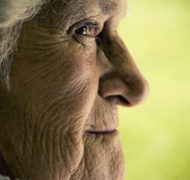Aging Well with Dr. Dan Blazer, Part 4: Geriatric Depression
Blog / Produced by The High Calling
“Depression causes more disability than any other psychiatric disorder,” Laity Leadership Institute senior fellow Dan Blazer, M.D. said his 2005 book The Age of Melancholy: Major Depression and Its Social Origins. In fact, depression is as disabling or more disabling than diabetes and hypertension, he said, and the World Health Organization estimated that it will be the second leading contributor to the “global burden of disease” by 2025.
Although those born in the later part of the 20th century suffer higher rates of depression than those born earlier, roughly 15 percent of the elderly experience significant symptoms.
A Crossword Puzzle Case Study
When The High Calling interviewed Dr. Blazer last fall, he talked about a patient who is close to 90 years old. The man had called Blazer a few weeks earlier to say he was feeling “terrible,” that he wasn’t sleeping and was losing weight, all of which are symptoms of depression.
The patient also said, “I’m not doing my crossword puzzles.”
“He had been doing crossword puzzles for 80 years,” said Blazer. “All of a sudden he wasn’t doing them. That signals loss of interest, which is another symptom of depression.”
Blazer prescribed medication. When he talked to the patient a few weeks later, he said he was feeling much better.
Blazer asked, “Are you doing your crossword puzzles yet?”
“No,” he replied.
The doctor knew then that the man wasn’t well yet and increased his medication dosage.
“He was sleeping better and his had appetite has returned, but, I’ll know he’s well when he starts doing his crossword puzzles again,” Blazer explained.
“If I were a family member and I had seen him doing crossword puzzles every day for 70 years, and then he stopped doing them and was just sitting in a chair, even though he might say he feels fine, I would be concerned about him,” he added.
Recognizing Social Causes in a Biological Age
In The Age of Melancholy, Blazer said that 70 percent of those who take antidepressants respond, and those who relapse do well with a combination of medication and psychotherapy. But he also warned that “something in therapists’ understanding and treatment of the disease is missing.” That something is insight about “the connection between the way we feel and the world around us.”
In working with younger colleagues to sketch a geriatric psychiatry research agenda for the future that focused on major depression, Blazer suggested including a study of prevention along with studies of brain imaging and clinical trials of new drugs.
“The social stressors of late life, such as the lack of economic resources or the fear of crime, seemed obvious topics to study,” said Blazer, but his colleagues were skeptical.
“No one had yet proved that changing the living conditions or the social context of an older adult would prevent late-life depression. But we were setting a research agenda for the future, not summarizing findings from the past. Could my colleagues believe that such an intervention was not even feasible? Could they totally discount the context of late-life depression and refuse to add explorations of the social origins of depression to the agenda? Yes, they could!” Blazer wrote.
He realized, to his dismay, that “social psychiatry had all but disappeared from the view of most modern psychiatrists.” Social psychiatry thrived during the 1960s, Blazer said, but has since been eclipsed by the medical model.
“Psychiatrists, it seems, have come to believe that if they label the person with a diagnosis such as major depression, they have said it all,” he explained.
Gulf War syndrome is an example in which specific physical toxins, such as oil well fires, are seen as the cause of a mental health problem.
“Although it should be noted that multiple factors can contribute to war syndromes, perhaps the most significant factors are ignored because they are not specific--that is, they are societal rather than physical,” Blazer said.
Other examples are smoking, obesity, and heart disease, all of which are now recognized to have social causes, as well as biological and psychological ones.
“Depression must be viewed as more than an interaction between a biologically vulnerable person and his or her behaviors toward a unique environment. Regardless of biological vulnerability, most first episodes of major depression are closely associated with a stressful life event, events often out of control of the individual,” said Blazer. “All cultures place individual experiences into agreed-upon social categories. Americans increasingly project the mood of depression onto biological processes, such as a chemical imbalance, and then turn to biology to validate that mood as natural and unique to the individual.”
The problem with this, he wrote, is that “major depression as a medical diagnosis effectively shapes and limits the explorations of its causes.” So, when clinicians diagnose someone with major depression, “they make a sharp distinction in a span of otherwise indistinct emotional suffering.”
Recognizing and Treating Symptoms
This narrow perspective contributes to the suffering of the elderly, many of whom don’t seek out mental health services, even when they perceive a need for them.
In Depression in Late Life, Blazer said that “if they are seen by a primary care physician or social agencies, the depressive symptoms may be overlooked or may not be diagnosed as a depressive disorder and therefore are not counted.”
For those who do manage to have their symptoms counted, “multiple interventions, if orchestrated effectively” are likely to be effective.
“Recognize the symptoms early and try to get help as early as you can. That, to me, is absolutely critical,” Blazer told us.
In a 2009 Christianity Today article, "The Depression Epidemic," he said, "Major depression is diagnosed when an adult exhibits one or both of two core symptoms (depressed mood and lack of interest), along with four or more of the following symptoms, for at least two weeks: feelings of worthlessness or inappropriate guilt; diminished ability to concentrate or make decisions; fatigue; psychomotor agitation (cannot sit still) or retardation (just sitting around); insomnia or hypersomnia (sleeping too much); significant decrease or increase in weight or appetite; and recurrent thoughts of death or suicidal ideation."
He described this definition as "sterile," however, and insufficient.
"Deep depression is embodied emotional suffering. It is not simply a state of mind or a negative view of life but something that affects our physical being as well," Blazer explained.
If you or a loved one experiences this kind of pain for more than a couple weeks, it may be time to reach out for help.





